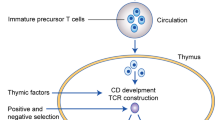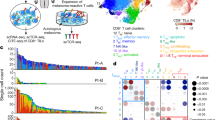Abstract
CELL-MEDIATED CYTOTOXICITY (CMC) against C3H/Umc (C3H) syngeneic mammary tumours measured in vitro, after in vivo immunisation, is mediated by cytotoxic T lymphocytes (CTL) and is directed mostly against cross-reacting antigens related to the mouse mammary tumour virus (MTV)1–3. The long-term CMC assay required for detecting this response against adherent target cells has complex kinetics and at least two superimposing components: (1) an initial early peak of cytotoxicity, detectable at approximately 6 h and accounting for 20–30% of the CMC, and (2) a later peak, detectable after 18–20 h and representing an additional 40–50% of the cytotoxic effect3. Both peaks are mediated by CTL with the Ly23 phenotype (that is, Ly1−Ly2,3+); however, non-cytotoxic T cells of Ly1 and probably Ly123 phenotype (that is, Ly1+Ly2,3− and Ly1+Ly2,3+, see refs 3 and 4 for nomenclature and functional characteristics of these T-cell subsets) are required for the expression of the second cytotoxic peak3. On the other hand, the short-term assays of CTL-mediated CMC show single-hit kinetics5, perhaps comparable to part of the early CMC peak in our system. During our studies of immunity to syngeneic mammary tumours, we observed that when C3H or C3Hf immune CTL were tested against allogeneic MTV-induced mammary tumour targets, a relative degree of H–2 restriction of CMC was observed2, although not of the magnitude detected in other systems using mostly short-term CMC assays6–11. The experiments reported here show that when the kinetics of the CMC response against adherent syngeneic and allogeneic mammary tumour targets were compared, some differences became apparent: whereas the early CMC peak showed absolute H–2 restriction, no restriction was observed in the late CMC peak, although both events were mediated by Ly23 CTL (ref. 3).
This is a preview of subscription content, access via your institution
Access options
Subscribe to this journal
Receive 51 print issues and online access
$199.00 per year
only $3.90 per issue
Buy this article
- Purchase on Springer Link
- Instant access to full article PDF
Prices may be subject to local taxes which are calculated during checkout
Similar content being viewed by others
References
Stutman, O. Cancer Res. 36, 739–747 (1976).
Stutman, O. Transplant. Proc. 9, 1153–1155 (1977).
Stutman, O., Shen, F. W. & Boyse, E. A. Proc. natn. Acad. Sci. U.S.A. 74, 5667–5671 (1977).
Boyse, E. A., Cantor, H., Shen, F. W. & McKenzie, J. F. C. Immunogenetics 5, 189 (1977).
Cerottini, J. C. & Brunner, K. T. Adv. Immun. 18, 67–132 (1974).
Zinkernagel, R. M. & Doherty, P. C. Contemporary Topics Immunobiol. 7, 179–220 (1977).
Shearer, G. M., Schmitt-Verhulst, A. M. & Rehn, T. G. Contemporary Topics Immunobiol. 7, 221–243 (1977).
Bevan, M. J. Cold Spring Harb. Symp. quant. Biol. 41, 519–527 (1977).
Gomard, E., Duprez, V., Henin, Y. & Levy, J. P. Nature 260, 707–709 (1976).
Blank, K. J., Freedman, H. A. & Lilly, F. Nature 260, 250–252 (1976).
Trinchieri, G., Aden, D. P. & Knowles, B. B. Nature 261, 312–314 (1967).
Plata, F. & Jongeneel, V. C. J. Immun. 119, 623–629 (1977).
MacDonald, H. R., Sordat, B., Cerottini, J. C. & Brunner, K. T. J. exp. Med. 142, 622–636 (1975).
Wettstein, P. J. & Frelinger, J. A. J. exp. Med. 146, 1356–1366 (1977).
Herberman, R. B. et al. J. natn. Cancer Inst. 53, 1103–1111 (1974).
Senik, A., Gisselbrecht, S. & Levy, J. P. Int. J. Cancer 16, 960–970 (1975).
Pang, T., Andrew, M. E., Melvold, R. W. & Blanden, R. V. Aust. J. exp. Biol. med. Sci. 55, 39–48 (1977).
Thorn, R. M. & Henney, C. S. J. Immun. 119, 973–978 (1977).
Burakoff, S. J., Germain, R. N. & Benacerraf, B. J. exp. Med. 144, 1609–1620 (1976).
Holden, H. T., Landolfo, S. & Herberman, R. B. Transplant. Proc. 9, 1149–1152 (1977).
Holden, H. T. & Herberman, R. B. Nature 268, 250–252 (1977).
Burton, R. C., Chism, S. E. & Warner, N. L. J. Immun. 118, 971–980 (1977).
Ting, C. C. & Law, L. W. J. Immun. 118, 1259–1264 (1977).
Author information
Authors and Affiliations
Rights and permissions
About this article
Cite this article
STUTMAN, O., SHEN, FW. H–2 restriction and non-restriction of T-cell-mediated cytotoxicity against mouse mammary tumour targets. Nature 276, 181–182 (1978). https://doi.org/10.1038/276181a0
Received:
Accepted:
Issue Date:
DOI: https://doi.org/10.1038/276181a0
This article is cited by
-
Natural and induced immunity to mouse mammary tumors and the mammary tumor virus (MuMTV)
Springer Seminars in Immunopathology (1982)
-
T cell recognition of antigen in vivo: Role of the H-2 complex
Springer Seminars in Immunopathology (1980)
Comments
By submitting a comment you agree to abide by our Terms and Community Guidelines. If you find something abusive or that does not comply with our terms or guidelines please flag it as inappropriate.



